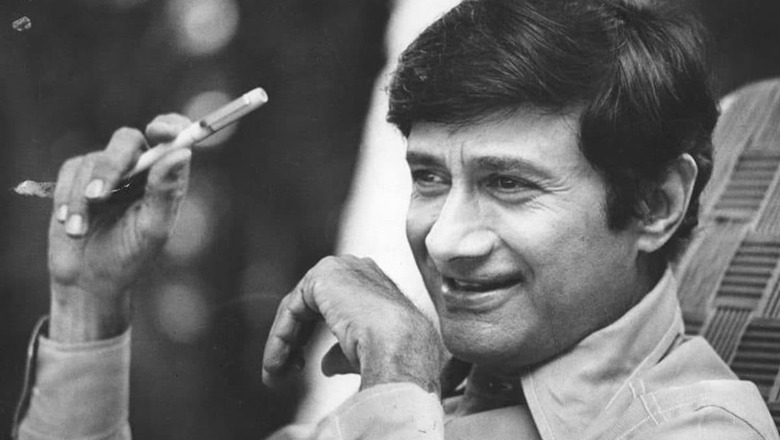
views
This September social media posts, panel discussions, news articles, music show are all about that ever-young Dev Anand, whose birth centenary is on the 26th of September. What was it about Dev Anand that stirs up the nostalgia even though his films stopped working at the box office decades ago?
His career began in 1946 with Hum Ek Hain. Ziddi (1948) was his first hit but the 1950s was the decade in which Dev Anand’s career gathered momentum with one of the key factors being the specific types of roles he essayed on screen. Which were these roles?
Independence brought with it the expectations for the youth of getting a white-collar job and a trendy life in the big city of Bombay which was the new Port of Hope of a free India for this youth migrating from small towns. Obviously, the films of the 1950s mirrored this as is evident in many films with Bombay as the backdrop. But there weren’t enough jobs for everyone in Bombay. This cramping represented the dark recesses of the city into which the unemployed youth were pushed into.
Dev Anand as Madan in Baazi (1951) desperately looks for proper work to raise funds for a permanent cure for his sister’s tuberculosis. Unable to find work, Madan is forced to join the notorious gambling den Star Club under suspicion of illegal gambling activities. Would a capable, unemployed youth watching Baazi not see himself in Madan? The stock dwelling of the young jobseeker of the 1950s is the noisy chawl, scant privacy and the homeless. As Ashok in House No. 44 (1955) Anand sleeping inside huge pipes amidst pelting rain again invokes this ‘people like us’ factor with the audience. Ashok refuses to live this deprived existence and joins a criminal gang. In his childhood Babu in Bombai ka Babu (1960) deserves no more than an admonishment for a juvenile offence. But his penury pushes him into the world of crime. In Kala Bazar (1960) Raghu (Dev Anand) loses his job as a bus conductor after a fight with a passenger. That Raghu failed to get a fair hearing and further, no other job anywhere in the metropolis points to the problem being a systemic one. To support two younger siblings and a widowed mother at home Raghu has no option but to sell movie tickets in black to earn a living. And he strolls the streets by night crooning ‘Teri dhoom har kahin (Ye, the almighty)’ sardonically extolling the supremacy of money. The pavement dwellers sleeping at night under the ever-present street bulb reflects the reality of the city’s reservoir while Raghu’s countenance alternating between light and shade is the metaphor of the differences between the ‘haves’ and the ‘have-nots’. Tony Fernandez’s story in Jaal (1952) is a strong, smart, young man. But instead of working hard and earning honest money like hundreds of other fishermen in Goa, he chooses to work for the smugglers. Tony is born defective with a propensity for the wrong, fast and the easy — nothing systemic about it.
Each such role was a brick in the wall with charcoal sketches of Dev Anand in grey & black shades.
In the 1950s while his peers, Raj Kapoor’s characters were the tragic tramp that appeared to demand sympathy and Dilip Kumar played the thoughtful, reticent romantic, Dev Anand essayed characters like Mangal in Taxi Driver (1954) put a smiling arm around the shoulders of life’s challenges, singing away ‘Mastram banke zindagi din ke din guzaar de (live life the way you please)’.
In an evidently Hollywood noir (of 1940s and ‘50s) inspired attire and demeanor, Dev Anand looked tailor made for the knee-length trench coats, a sporty beret, open necked shirts, an outlandish scarf, a two-day old stubble, and a cigarette, looking at home in a bar with a pretty girl singing. And importantly, the haughty swagger that carried the delicate aroma of forbidden scents. His face was a ‘mask’. His expression could change instantly from a furtive one looking askance to one that smiled brilliantly straight into your eyes. In Baat Ek Raat Ki (1961), when Neela (Waheeda Rehman) admits to being in love with Ranjan (Chandashekhar) the mask of the learned advocate Rajeshwar (Dev Anand) drops momentarily to reveal green jealousy. As Lord Meghnad Desai puts it in his book Nehru’s Hero Dilip Kumar, “Dev Anand was the young urbane man straddling the boundary between the police and the criminal.:
It is not that all of Dev Anand’s roles of the 1950s were dark or anti-hero ones. He played the good man in successful outings like Sazaa (1951), Patita (1953), Munimji (1955), Funtoosh (1956), Paying Guest (1957), Nau Do Gyarah (1957), Solva Saal (1958), Love Marriage (1959), Kala Pani (1958). In the 1960s, as he comfortably crossed forty without aging a day, Dev Anand retained a couple of traits of his dark shades of the 1950s. The first one was romancing more than one woman with no perceivable qualms. We saw that in Jaal (1952) where Tony could charm her out of her hutment to the balmy beachside on a moonlit night at will.
In Teen Deviyan (1966) Dev romanced three women cheating on none of them. It was just a young man exercising his right of choice. In Jewel Thief (1967), the count of women went up to five which included a right-up-to-the-edge flirting with Anjali (Tanuja) and a one-night stand with Helen (Helen) — albeit for business reasons. In Joshila (1974), Amar (Dev) hesitates for a moment before agreeing to get enticed by his wealthy employer’s sexy wife (played by Bindu).
A profession like a glamour photographer on the lookout for a bikini model in Heera Panna (1973) fitted him snugly. ‘Daudi chali aati hain, mai jisko pukarta hoon (the women are at my beck and call)’ he sings, losing none of the swagger even at 50. Second, his characters hovered close to breaking the law, the best example being that of Raju in his magnum opus Guide (1965). Smooth tongued and cocky, Raju’s immature fear of losing Rosie finally entraps him into committing a federal offence of forging Rosie’s signature. In Joshila (1974) and Banarasi Babu (1973) he plays an imposter.
His slanting gait, his urbane disposition, the smile with his head cocked, the occasional pursing of his mouth accompanied with a couple of quick nods and the express-speed dialogue delivery lent him an inimitable style that many loved to imitate. Said Prem Chopra, “Once somebody worked with him for 10-15 days, I bet everybody will talk like him, walk like him, behave like him”. After a particular point it didn’t matter whether his films clicked or not. They didn’t, after Des Pardes (1978). But people took pride in their association with him and enjoyed his infectious passion for film making and acting.
He would have turned hundred this year and yet Dev Anand’s personal magnetism would have risen above everything else.
Balaji Vittal is a National Award winning and MAMI Award winning author, a Bollywood commentator and a public speaker. He can be reached on Twitter at @vittalbalaji and his website is www.balajivittal.com. Views expressed in the above piece are personal and solely that of the author. They do not necessarily reflect News18’s views.



















Comments
0 comment